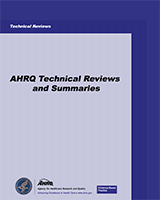Behavioral and Physical Treatments for Migraine Headache
Technical Reviews, No. 2.2
Authors
Contributing Authors: Ruth E Goslin, MAT, Rebecca N Gray, DPhil, Douglas C McCrory, MD, MHSc, Donald Penzien, PhD, Jeanetta Rains, PhD, and Vic Hasselblad, PhD.Affiliations
Structured Abstract
Objectives:
To identify and summarize evidence from controlled trials on the efficacy of behavioral and physical treatments for migraine.
Search strategy:
A strategy combining the MeSH term “headache” (exploded) and a previously published strategy for identifying randomized controlled trials was used on the January 1966 to December 1996 MEDLINE database. Other computerized bibliographic databases, textbooks, and experts were also utilized.
Selection criteria:
English-language controlled trials involving patients with migraine in which at least one treatment offered was a behavioral or physical treatment were selected.
Data collection and analysis:
Measures of headache index and headache frequency reported as group means (and standard deviations) were used to calculate standardized mean differences (or effect sizes). Where similar trials provided data, meta-analysis of efficacy measures was performed. The number of patients obtaining at least a 50% reduction in headache index, frequency, or severity was recorded and used to calculate odds ratios.
Main results:
Behavioral treatments for migraine have a consistent body of research indicating efficacy. Summary effect sizes from a meta-analysis of 18 trials suggest that relaxation training, thermal biofeedback combined with relaxation training, electromyographic (EMG) biofeedback, and cognitive-behavioral therapy are all modestly effective in treating migraine when compared to a wait-list control. Thermal biofeedback alone or combined with cognitive-behavioral therapy yielded similar effect sizes that failed to reach statistical significance. Physical treatments have been less often studied. Six small trials of acupuncture yielded mixed results. Other physical treatments for which controlled trials have been reported include transcutaneous electrical nerve stimulation (TENS) (2 trials), cervical mobilization and manipulation (1 trial), occlusal adjustment (1 trial), and hyperbaric oxygen (1 trial).
Conclusions:
Each of the behavioral therapies considered has modest efficacy for migraine. There is little information about which patients will benefit from particular behavioral approaches; the choice among them may, for the present, depend more on availability and acceptability than on data about efficacy. There are insufficient data about any of the physical treatments to draw conclusions about their efficacy.
Project Directors: Douglas C McCrory, MD, MHSc, David B Matchar, MD. Project Manager: Rebecca N Gray, DPhil. Research Assistants: Louise Nobles, RN, Susan Farese, RN, Pramod Gumpeni, BA. Technical Advisors: Jay Rosenberg, MD, Stephen Silberstein, MD, Donald Penzien, PhD, Fred Sheftell, MD, Steven Baskin, PhD, Ronald Kaiser, PhD, Alvin Lake, PhD, Kenneth Lofland, PhD, Dawn Marcus, MD, Russell Packard, MD, Jeanetta Rains, PhD, Robert Roeshman, DO. AHCPR Project Officer: Ernestine Murray, RN, MAS.
Prepared for: Agency for Health Care Policy and Research, Department of Health and Human Services, U.S. Public Health Service, Rockville, Maryland. Contract No. 290-94-2025. Prepared by: Center for Clinical Health Policy Research, Duke University.
Suggested citation:
Duke University, Center for Clinical Health Policy Research. Behavioral and Physical Treatments for Migraine Headache. Technical Review 2.2. February 1999. (Prepared for the Agency for Health Care Policy and Research under Contract No. 290-94-2025. Available from the National Technical Information Service; NTIS Accession No. PB99-127946.)
This document does not necessarily represent the views of the Department of Health and Human Services. It is available from the National Technical Information Service at 1-800-553-6847.
